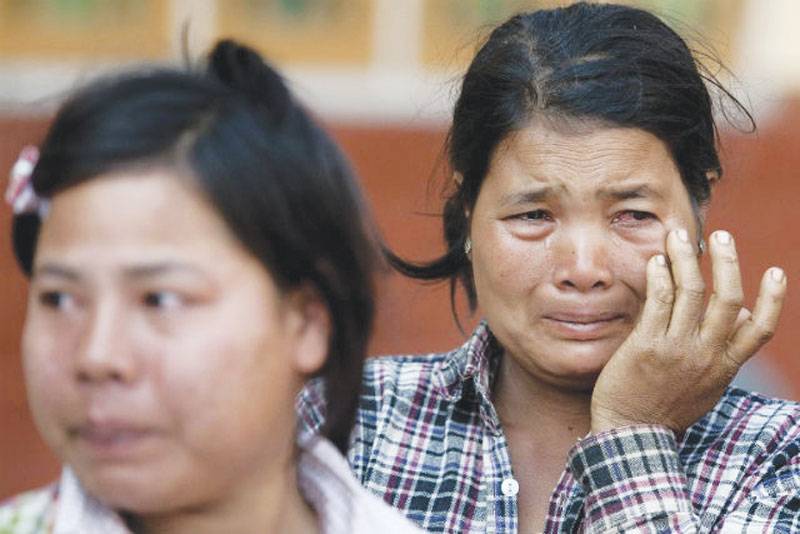LASHIO, Myanmar - Myanmar’s army intensified an offensive to flush out rebels from areas around a flashpoint town on the northeastern border with China, state media said Friday, after 11 days of fighting displaced tens of thousands of people.
The conflict, which flared on February 9 when ethnic Kokang rebels killed nearly 50 soldiers during a series of attacks on Laukkai town, has seen at least 30,000 people flee into China, prompting Beijing to call for an end to the clashes.
A similar number of people are believed to be displaced within Myanmar’s northern Shan State, but clear estimates are hard to glean as local aid groups have limited operations after a Myanmar Red Cross convoy came under fire.
The army has struck back against the rebels with air strikes and ground forces, after apparently being caught flat-footed by the pace and ferocity of the initial rebel assault.
“Army columns were in hot pursuit of Kokang insurgents into retreat,” around the Laukkai area, state mouthpiece the Global New Light of Myanmar reported Friday.
The report said the bodies of two rebels were recovered by Myanmar soldiers after fighting early Thursday to secure roads leading to Laukkai, which is now an apparent ghost town.
Rebels say they have also inflicted casualties on the army over recent days.
The conflict has renewed doubts over a government attempt to forge a nationwide ceasefire in a country peppered with bitter ethnic insurgencies.
The Kokang, who are mainly ethnic Chinese, have continued ambushes on army convoys despite losing dozens of men in the government push back.
They have been joined by other nearby rebel groups, including the Ta’ang National Liberation Army and the powerful Kachin Independence Army, an ominous sign for peace in the country as it opens up and heads towards a crunch general election later this year.
Civilians have continued to stream into the Shan town of Lashio, some 140 kilometres (85 miles) from the fighting.
“We left yesterday (Thursday) morning because we were scared,” a tired, sunburnt 50-year-old woman taking shelter at a Lashio monastery told AFP on Friday.
“The fighting was continuous... we could see the firing. One day it started around 3 pm and went on until the next morning,” she added, requesting anonymity.
On Friday around 500 people were camped at the monastery where thousands who have fled the violence, many of them temporary workers, have taken refuge before travelling on to their homes in other parts of Myanmar.
Vice President Sai Mauk Kham was due to visit the site later Friday as the latest senior official to travel to Lashio after meeting wounded soldiers at the local military hospital.
Efforts to evacuate remote communities have been hampered by Tuesday’s attack on a local Red Cross convoy which wounded two aid workers.
It is unclear who shot at the six-vehicle convoy, which was carrying civilians and journalists.
On Friday the United States Embassy in Yangon condemned the attack as “unacceptable”.
Myanmar has blamed Kokang rebel leader Phone Kya Shin for the upsurge of violence - after six years of relative peace - and called on Beijing to rein in any local officials who might be helping the group on its side of the border.
Reform-minded President Thein Sein has vowed “not to lose an inch of Myanmar’s territory” to the rebels.
Saturday, April 20, 2024
Myanmar army deepens offensive on rebels

8:27 AM | April 19, 2024
8:09 AM | April 19, 2024
Pak economy improving, funds will be provided on request: IMF
9:57 PM | April 19, 2024
Minister advocates for IT growth with public-private collaboration
9:57 PM | April 19, 2024
Judges' letter: IHC seeks suggestions from all judges
9:55 PM | April 19, 2024
Formula 1 returns to China for Round 5
9:05 PM | April 19, 2024
Germany head coach Julian Nagelsmann extends contract till 2026 World Cup
9:00 PM | April 19, 2024
A Tense Neighbourhood
April 19, 2024
Dubai Underwater
April 19, 2024
X Debate Continues
April 19, 2024
Hepatitis Challenge
April 18, 2024
IMF Predictions
April 18, 2024
Kite tragedy
April 19, 2024
Discipline dilemma
April 19, 2024
Urgent plea
April 19, 2024
Justice denied
April 18, 2024
AI dilemmas unveiled
April 18, 2024
ePaper - Nawaiwaqt
Advertisement
Nawaiwaqt Group | Copyright © 2024





